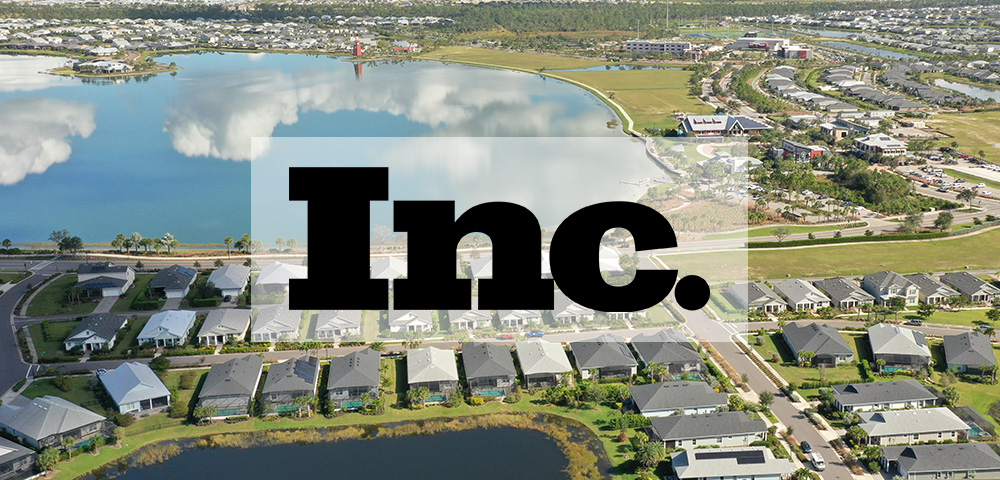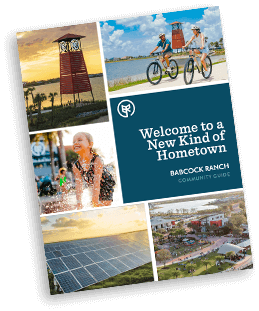The town of Babcock Ranch was built to withstand hurricanes. And it runs almost entirely on solar energy.
BY ERIKA THOMAS
Imagine an American town that’s powered almost entirely by solar energy, where commercial and residential development is balanced with natural green space and ecosystems, and the infrastructure is specifically designed to withstand natural disasters.
You don’t have to imagine too hard—because it exists. Nestled near the Southwest coast of Florida, lies the self-proclaimed “hometown of tomorrow.” And it’s living up to the hype.
Babcock Ranch, current population 9,200, is a planned community led by former NFL player Syd Kitson, co-founder of Babcock Ranch and Chairman and CEO of real estate company Kitson & Partners. The town exists within a sprawling patch of Floridian real estate that measures 18,000 acres, with half of the town’s footprint set aside as greenways, parks, and expansive lakes, helping to preserve natural occurring flora and fauna.
This isn’t a vanity project. For Kitson, it’s equal parts duty and entrepreneurial ambition—and it showcases how businesses are stepping up to find innovative solutions to climate change and extreme weather events.
“The private sector should always step up first—that’s the definition of innovation,” says the former Green Bay Packer. “I believe in leaving this world better than when I came into it. For me, that meant creating something that can inspire others to innovate, working with the environment, and conserving invaluable resources for future generations.”
He seems to be succeeding.
Since its inception, Babcock Ranch has garnered attention from development organizations and mainstream media as an ideal model for new communities, not just for its ecofriendliness, but also for its ability to withstand the extremes of Floridian weather.
Recently, The Resilient Design Institute led a case study on Babcock Ranch, citing its stability in 140mph force wind gusts and flooding that devastated surrounding parts of Lee and Charlotte Counties in 2022 with Hurricane Ian. And according to the New York Times’ coverage, The Field House building in the center of town, “held about 500 evacuees during Hurricane Ian, which passed over the community as a Category 4 storm.” Though Hurricane Ian caused $120 billion in both insured and uninsured losses, Babcock Ranch had little damage.
In 2024, Hurricane Milton was another test for Babcock Ranch, as it was the shelter of choice for over 2,000 Floridians from nearby areas. For town residents and neighboring vicinities, Babcock Ranch’s Field House facility is regarded as the best place to evacuate to when seeking shelter from a storm, along with the K-12 school that supports the town’s next generation.
The town’s resilience can be attributed to its planning. Babcock Ranch was built 30 feet above sea level. Cognizant of the delicate ecosystem, developers took precautions against extreme weather events, like designing smart ponds to combat flooding and burying utilities underground. The roads were built around existing drainage patterns rather than redirecting water via concrete and pipes. Even more, there’s a smart stormwater system of remote-controlled dams that can proactively lower lake water levels in advance of a large storm.
Beyond its civil planning, Babcock Ranch has tapped into the power of partnerships to keep pushing the envelope on what’s possible in sustainable planning.
Creating a community around a sustainable vision
In 1914, Babcock Ranch was owned by Pittsburgh-transplant Edward Babcock who used the land for timber farming, and cattle ranching. In the 1940s, the Babcock family donated pieces of the land to Florida’s Commission of Game and Fresh Water Fish, and after his death, the State of Florida purchased large swaths of the land, making it a protected site to preserve the native ecosystem, which includes the Southwestern Everglades.
Kitson and his firm purchased 91,000 acres in 2006, and Kitson sold 73,000 of those acres back to the State of Florida for permanent preservation—the largest land conservation deal in Florida’s history, according to Babcock Ranch’s website and the Florida Department of Agriculture and Consumer Services
“Sustainability has been a passion of mine since college and developing Babcock Ranch has become a lifelong project that illustrates to the world that building with, and not against, nature is possible, scalable, and financially accessible to all,” says Kitson. “I wanted to create a new city that works in harmony with nature. Babcock Ranch serves as an inspiration for communities around the world seeking to leave a positive, or neutral, impact on the planet.”
In 2016, Kitson began building his community, which would aim to be cognizant and respectful of the natural landscape, without consuming excess energy, and accommodating to multi-generational needs.
The groundwork for this vision required an energy plan. For that, Kitson tapped Florida Power & Light Company. In 2015, Kitson & Partners gave FPL 440 acres for the first 75-megawatt solar array, a substantial amount of energy considering typical utility-scale solar farms begin at 30 to 40 acres and produce 5 megawatts per day. FPL purchased another 400 acres to build a second array of panels, for a total of 700,000 panels to date with an output of 150 megawatts. That’s enough to power 30,000 homes—which is more than Babcock Ranch’s housing stock at full buildout. Residents pay a solar utility bill, it is not free for them. But the setup ensures a continual energy source for the town. The rest of the power is fed into the FPL grid.
In addition to the large, ground-mounted solar array, most of the commercial buildings have extensive solar arrays on their roofs. In keeping with the rest of town, the panels are also designed to withstand Category 5 hurricane (157 mph) winds.
The actual buildings and structures would need to be built with sustainability in mind, too. In December 2024, with D.R. Horton and BamCore as partners, Babcock Ranch launched a construction pilot project in its Palmetto Landing neighborhood with the goal of reducing the carbon footprint of house framing, overall construction time, and material waste. Through an ultra-sustainable prefabricated framing system made by BamCore, the pilot proved successful—structural walls and trusses of a house were installed in under three hours, a speed which is unheard of in traditional construction.
Of course, the durability of the materials would be key. Southwest Florida experiences increasing hurricanes and tropical storms, the project is only as good as it is strong.
Ensuring the community can flourish
In December 2024, D.R. Horton’s Southwest Florida Division President, Justin Robbins, confirmed that BamCore’s products are tested to “Miami-Dade standards” and that they’d hold up under pressure–and the heat. “Initial assessments suggest we could see thermal performance improvements of up to 55 percent compared to traditional framing methods.”
Babcock Ranch is also largely affordable. While at the top of the range, some Babcock Ranch homes are priced closer to $4 million, the town wasn’t built only to serve the wealthy. Housing prices start in the upper $200,000s—a bargain in a state where the average home is priced closer to $400,000.
The inventory is moving in Babcock Ranch, and the market is there for sustainable and responsibly built housing. According to a recent national Zillow Consumer Housing Trends Report, 86 percent of 2024 home buyers prioritized climate disaster resiliency features in buying a home.
They also want to enjoy where they live. For this, Babcock’s planning commission prioritizes preservation and green initiatives. Among other things, the community recently opened its first set of 6 parks along a 3.5-mile stretch of green space (known as The PKWY) and spans 313 acres of Curry Creek Preserve. That ecological project balances with a newly announced building project—an Urgent Care facility managed by Tampa General Hospital, designed to benefit the residents.
To tie in to youth, one of the first projects opened in Babcock Ranch was a community school, which began operating shortly after the town officially opened in 2017.
Other future plans include more on-location places for residents to live, learn, work, and play. The amenities also help contribute to the community’s sustainability goals, as greater access to resources closer to home means less time commuting in cars.
Establishing innovation as a living principle
Sustainable development is not a new concept. Almost a decade ago, when the United Nations rolled out its Sustainable Development goals for 2030, some companies stepped up. Some didn’t. According to the World Economic Forum, some goals have actually reversed progress and worsened since targets were set.
To be sure, Kitson does think the government can be useful. He believes stricter regulation is needed to make an impact. “The government,” he says, “can often serve as an important partner, validator and additional funder that can take a unique idea and make it even bigger.”
But he adds that “private business should not rely on the government to get the ball rolling.”
When asked why Babcock Ranch chose the route of holistic sustainable development, Kitson’s answer leads to a willingness to accept the risks of innovation.
“There’s an inherent risk associated with being an innovator—what if it doesn’t work? Here at Babcock Ranch, we’re willing to take that risk and prove that mother nature and a new town can work together.

